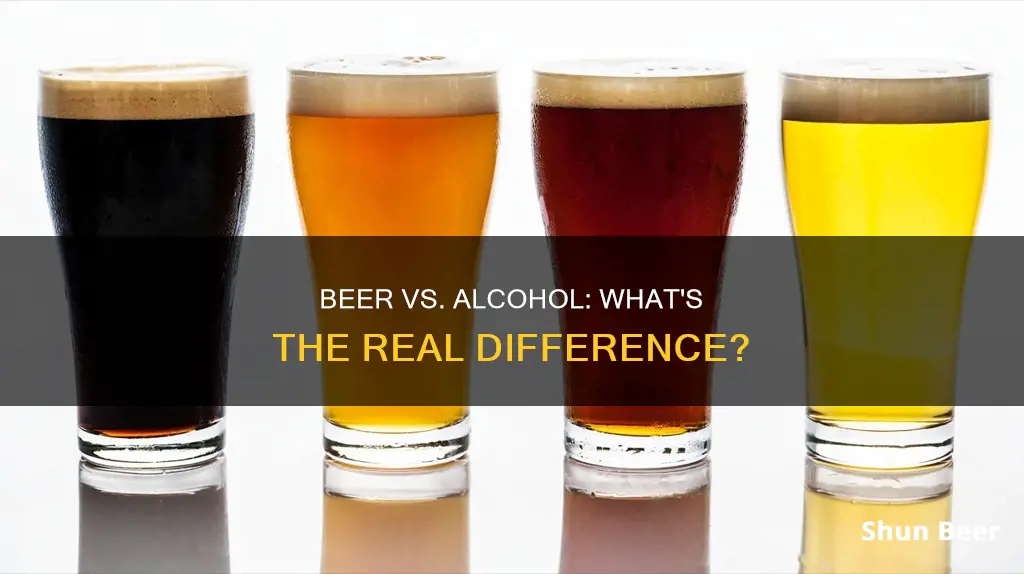
Beer and ale are both types of fermented alcoholic drinks made with grains, water, yeast, and hops. However, beer is a broader term, encompassing various styles and flavors, while ale is a specific type of beer made with a different kind of yeast and fermented at a different temperature. Ales are typically warm-fermented using yeast that ferments at higher temperatures, resulting in a fruitier, more complex flavor profile. Lagers, on the other hand, are cold-fermented at lower temperatures, producing a smoother, crisper flavor.
| Characteristics | Values |
|---|---|
| Broader term | Beer |
| Specific type | Ale |
| Yeast | Lager yeast: saccharomyces uvarum; Ale yeast: saccharomyces cerevisiae |
| Fermentation | Lager: bottom-fermenting; Ale: top-fermenting |
| Temperature | Lager: cooler; Ale: warmer |
| Flavour | Lager: smooth, crisp; Ale: complex, fruity |
| Colour | Lager: light; Ale: dark |
What You'll Learn

Beer is made through fermentation, liquors are distilled
Beer and liquor are both alcoholic beverages, but they differ in terms of their production methods and alcohol content. Beer is made through fermentation, while liquors are distilled.
Fermentation vs Distillation
Fermentation and distillation are two different processes used to produce alcohol. Fermentation involves the conversion of carbohydrates (such as starch or sugar) into alcohol using yeast. This process is used to make beer, as well as other beverages like wine, hard cider, mead, saké and non-distilled spirits. Distillation, on the other hand, is a method of separating alcohol from water through evaporation and condensation. This process purifies and concentrates the alcohol, resulting in a higher alcohol content. Distillation is used to produce liquors such as brandy, gin, rum, vodka and whiskey.
Beer Production
Beer is typically made using four main ingredients: malt (usually barley, but also oats or rice), hops, water and yeast. The grains are roasted, dried and milled to release the enzymes needed for brewing. The milled malt is then mixed with hot water to create a sweet liquid called wort. Hops are added to the wort to give beer its distinctive bitter, citrussy and earthy taste. The mixture is boiled and then cooled before yeast is added to begin the fermentation process. During fermentation, the yeast breaks down the sugars and converts them into alcohol and carbon dioxide. The beer is then left to mature, filtered, and packaged into bottles, cans or kegs.
Liquor Production
Liquor, or distilled spirits, are produced by distilling grains, vegetables or fruits. The process begins with preparing the mash, which involves fermenting the base ingredients such as grains, grapes or other fruits. Yeast is added to start the fermentation process, converting sugars into alcohol. After fermentation, the base alcohol is heated to separate the alcohol from the water through distillation. This process is done in stills, which can be continuous or pot stills. The distilled spirit is then matured in wooden barrels or other vessels, blended, proofed and filtered before being bottled.
Alcohol Content
In addition to the different production methods, beer and liquor also differ in their alcohol content. Liquor tends to have a higher alcohol content than beer, with a higher alcohol by volume (ABV). This means that liquor can have stronger effects and lead to quicker intoxication compared to beer.
A Wide Variety of Beers at Yard House
You may want to see also

Liquors have a higher alcohol content than beer
It's important to understand the alcohol content of different beverages to make informed decisions about drinking. Alcohol by volume (ABV) is the standard measure of alcohol content, indicating the volume of ethanol as a percentage of the total volume of the drink. While beer, wine, and liquor all contain alcohol, their alcohol content can vary due to differences in the fermentation and distillation processes used to make them.
Liquor, also known as spirits, typically has a higher alcohol content than beer. The average ABV for beer is around 4.5–5%, while liquor has an average ABV of 37%, with some liquors reaching as high as 40–60% ABV. This means that a standard serving of liquor (1.5 ounces or one shot) contains about 40% alcohol, compared to a standard serving of beer (12 ounces or one bottle), which contains about 5% alcohol.
The higher alcohol content in liquor is achieved through distillation, a process that separates the water from the alcohol, resulting in alcohol concentrations of at least 20%. In contrast, beer is primarily made through the fermentation of barley or other grains, and the yeast used in this process typically becomes inactive when alcohol levels climb above 10%.
While a standard serving of beer may have less alcohol than a standard serving of liquor, it's important to note that serving sizes can vary, and individuals may consume more beer in a single sitting than they would with liquor. Additionally, liquor is often mixed with non-alcoholic beverages, making it easier to consume more alcohol in a short period.
Consuming excessive amounts of alcohol, regardless of the type, can lead to negative health consequences and increase the risk of addiction. It's important to drink in moderation and understand the alcohol content of different beverages to make informed and responsible choices.
Beer vs Lager: What's the Difference?
You may want to see also

Beer has a calorie range of 95-210 calories
Beer is made from fermented grain, and the calories in beer come from carbohydrates and alcohol. The number of calories in a beer depends on the brew and the amount consumed. Generally, craft, seasonal beers, and beers with high alcohol content have more calories than lighter beers. Alcohol provides seven calories per gram, so beers with a higher alcohol content will have more calories.
Beers can range from light and under 100 calories to dark and flavourful with more than 200 calories. For example, a 12-oz can of ale, lager, porter, premium beer, or stout has more than 12 grams of carbohydrates, which is about four times more carbs than a light beer.
Some of the lowest-calorie beers include Michelob Ultra, Busch Light, and Beck's Premier Light, which contain 95, 95, and 64 calories, respectively. Beers with fewer than 100 calories include Michelob Ultra Amber, Miller Light, and Amstel Light, which contain 89, 96, and 96 calories, respectively.
Most 12-ounce beers provide around 150 calories. Beers in this range include Coors Light, Stella Artois, Bud Light, Budweiser, Beck's Dark, and Bud Light Lime.
Beers with higher alcohol content and more calories include Blue Moon Cappuccino Oatmeal Stout, Blue Moon Belgian White, Sierra Nevada Pale Ale, and Beck's Octoberfest. These beers range from 168 to 196 calories.
IPAs can have a high alcohol content and a high calorie count, with some containing more than 300 calories in 12 ounces. However, the average IPA is about 180 to 200 calories for 12 ounces, and some lighter IPAs are under 100 calories.
Exploring Belgium's Diverse Beer Culture: A Tasty Overview
You may want to see also

Liquors are often mixed with other drinks, increasing calorie count
Liquors are often mixed with other drinks, which can significantly increase their calorie count. For example, a piña colada, a cocktail typically made with rum, can contain up to 340 calories. Similarly, a classic daiquiri, another rum-based cocktail, can contain around 259 calories. The extra ingredients in these drinks, such as coconut water, pineapple juice, or simple syrup, contribute to their high calorie counts.
Another example of a liquor that is often mixed with other drinks is vodka. A vodka soda has a relatively low calorie count, but when mixed with fruit juices or other caloric beverages, the calorie content can increase significantly. For instance, a vodka cranberry cocktail can contain up to 200 calories, depending on the amount of juice used.
Tequila is also commonly mixed with other drinks, leading to a higher calorie count. A tequila sunrise, for example, contains approximately 232 calories per serving, while a margarita can contain up to 168 calories. These mixed drinks often include sugary ingredients such as orange juice, grenadine syrup, or triple sec, which contribute to their high calorie content.
In addition to the examples mentioned above, many other liquors are frequently mixed with other drinks, resulting in higher calorie counts. It is important to be mindful of the additional calories that can come from mixing liquors with other beverages, especially if one is conscious of their calorie intake or overall health.
Wheat Beer vs Lager: What's the Difference?
You may want to see also

Beer is the most common alcoholic beverage globally
Beer is the most commonly consumed alcoholic beverage worldwide. In fact, after water and tea, beer is the world's third most popular drink. Beer is made from a combination of water, hops, malt, yeast, and fermentation time. The most significant difference between beer styles is the type of yeast used.
Lagers and ales are the two main subgroups of beer. The type of yeast and fermentation temperature distinguish these two subgroups. Ales are produced using a top-fermenting process with the yeast species saccharomyces cerevisiae at room temperature, resulting in a lighter colour. Lagers, on the other hand, are produced using a bottom-fermenting process with the yeast species saccharomyces pastorianus at a lower temperature.
Lagers are typically easier to drink, and most of the top-selling beers worldwide are lagers. They are crisp, clear, and refreshing. Ale, on the other hand, is a top-fermenting beer where the yeast rises to the top of the container during brewing and then sinks back to the bottom when the process is complete. Ale is the preferred choice for home and small-batch brewers due to the yeast's easy availability and fast fermentation process.
The global beer market is expected to continue growing in the coming years, driven by factors such as the demand for premium and low-calorie beers, the rising popularity of craft beer, and the expansion of distribution networks in emerging countries.
Tequila vs Beer: A Different Drunk?
You may want to see also
Frequently asked questions
Beer is a broader term, encompassing various styles and flavours. Ale is a specific type of beer made with a different kind of yeast and fermented at a different temperature.
Ales are "warm fermented", using yeast that ferments at higher temperatures, while lagers are "cold fermented", using different yeast that ferments at lower temperatures.
Examples of lager include Pilsner, Bock, and Marzen, while examples of ale include Pale Ale, India Pale Ale, and Wheat Beer.







